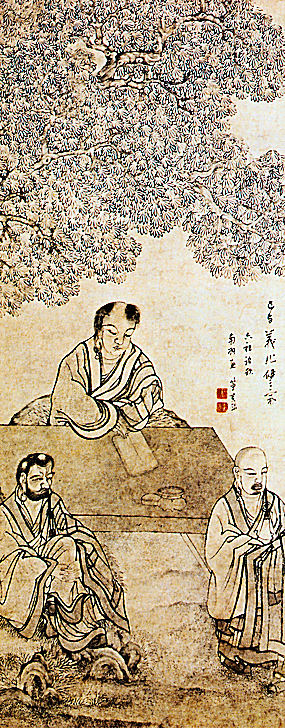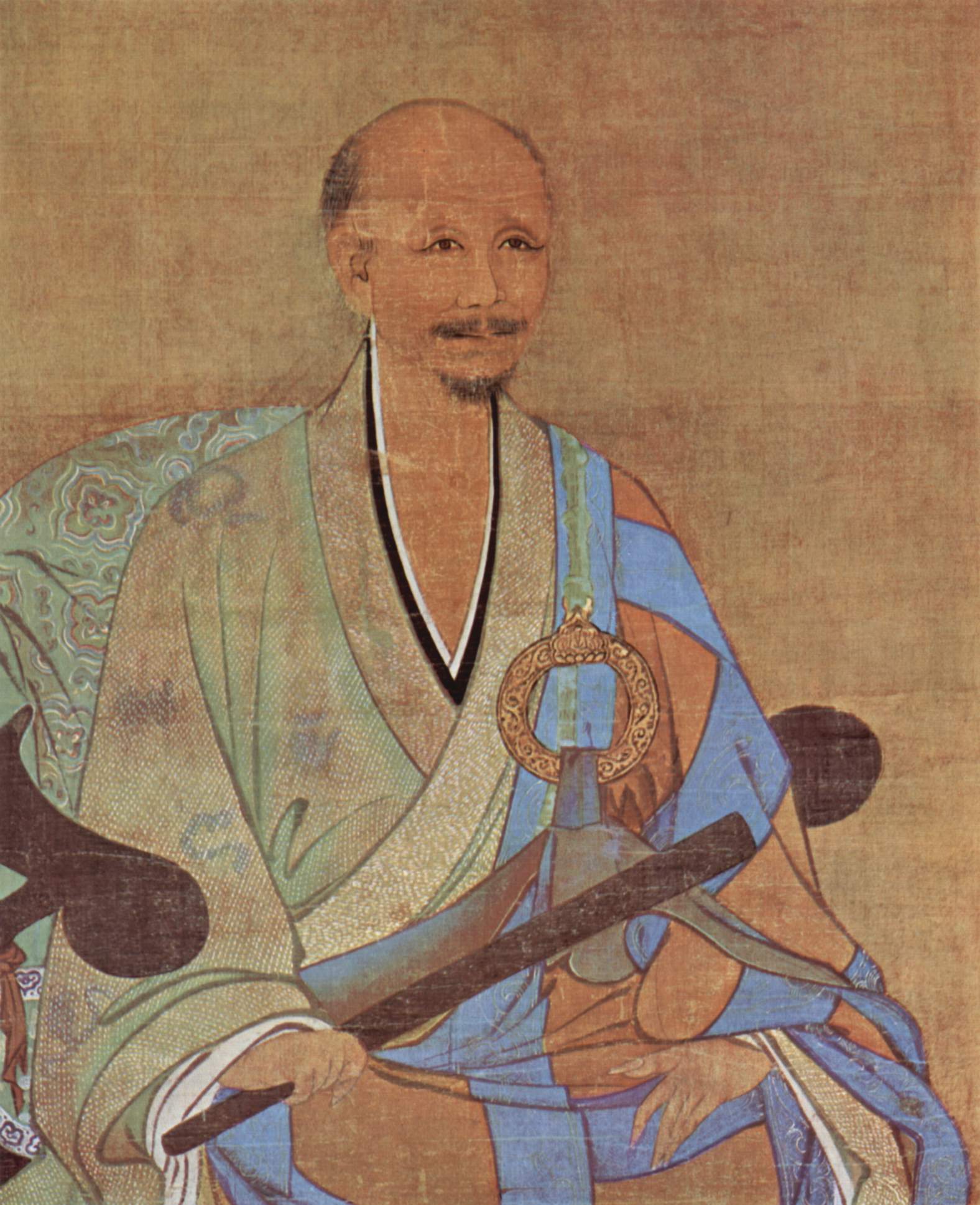Chinese Chán
Chan (Chinese禅/禅, Pinyin Chán ) is a resultant in Imperial China meditation school of Mahayana Buddhism, which is characterized by the practice of meditation in the lotus position and by solving Gongans (Jap. koan ), a kind of paradoxical puzzles, as well as experience of enlightenment is. Chan is a created in China by meeting with Daoism and Confucianism form of Buddhism. He has had a great influence on Chinese philosophy, art and culture.
The Chinese name Chan comes from the Sanskrit word dhyana, which was transmitted as禅 那( Chán'nǎ ) in Chinese. The Chan Buddhism was widespread in East Asia and Southeast Asia by the monks. There was then a Korean ( Seon, korean. 선 ) and Vietnam ( Thien ) tradition. The Chan Buddhism was transmitted to Japan in the 12th century and is known there as Zen.
Teaching
Of Chan Buddhism was founded according to legend by Bodhidharma 480-520 AD. He is said to have completely based on meditation and rejected any written tradition. However, it is also reported that he was a follower of the Lankavatara Sutra, which emphasizes the inner enlightenment. Accordingly, in the Chan transmission of the doctrine is not found with the help of writings but from master to disciple and "heart to heart " instead, although there were some text collections of Chan masters and also the Prajnaparamita, the Lankavatara and the Nirvanasutra played a role. However, the greatest value always had the Diamond Sutra.
The concept of Wisdom Sutras is designed to Chan as looking through the emptiness of the world of phenomena, properties and forms of things and the accrued person to advance to nothingness. Prajna and Sunyata, wisdom and emptiness, as the same reality can be seen, so that is spoken in the Chan of non- spirit and non- thought. These are explained as simultaneously existent and non-existent, incomprehensible and the unthinkable itself outside and inside as well as being and non-being should be abandoned completely in Chan to find the original Buddha nature and to capture the true reality through them. Accordingly rejects Chan from the traditional philosophical opinions on the sutras, as the teachings of Chan based on direct experience and refer to one's self. The correct position is in accordance with the Chan absence of viewpoints. In the history of Chan came so often the case that Chan master ritually burned sutras and statues destroyed.
The aim of Chan is enlightenment or awakening (Jap. satori ), which could be achieved by different means. One of them was the Gong'ans公案(Jap. koan ), sentences or cases that were not solved rationally and served the transcendence of the mind, but always played the deeper meditation in all schools of Chan 's most important role.
The influence of Daoism is reflected in the tendency to conceptual negation, emphasizing the emptiness and unity as the Absolute and the high value of nature as self-nature, Dharmanatur, Wisdom Nature and Buddha nature.
Negative terms such as the non-existence ( Wuyou ), non-action ( wu wei ), non- thinking ( wunian ) and non- consciousness ( Wuxin ) were important for the Chan Buddhism, and the philosophy of Chan always distinguished himself as a philosophy of paradox and the way the radical freedom of the mind. Chan emphasizes the unity of the Spirit with the Buddha nature that can be experienced only in the present existence, or always exists and presents itself as a path of practice and not of philosophical speculation, as they excelled other schools of Buddhism in China.
History
As the founder and first patriarch of Chan and Zen Buddhism later applies the Indian monk Bodhidharma. He came after a journey across the Himalayas and southern China around 523 AD. in the northern Chinese province of Henan. In the hitherto dominated Shaolin Taoist monastery, he introduced his meditation and teaching practice that has been carried on from there. Some sources, also the martial art of Kung Fu, were known for the Shaolin monks in the 20th century in the West, there had been founded by him.
All still existing schools lead back to the Sixth Patriarch Huineng ( 638-713 ). In the aftermath of Huineng, many schools of Chan formed. The heyday of Chan in China had emerged during the Tang and Song dynasties, as important collections of sayings and works in dialogue form, and also the Chinese culture and art were influenced. An important figure is the poet Wang Wei, but also the theorist Zongmi.
In the early history of Chan protrudes a significant event, the separation into a Northern and a Southern school school. The North realized enlightenment as a gradual process that is to be realized by constant practice of meditation, while the Southern school stressed that enlightenment was a sudden moment. In the course of history, the Southern school prevailed, so that Satori is also today still defined as a sudden awakening to the true reality.
In the Chan - after Huineng movement protrude during the Tang period Mazu Daoyi, Baizhang Huaihai, Huangbo Xiyun ( jap: Obaku Kiun ) and Linji Yixuan (Jap. Rinzai ) out. Make the Chan patriarchs represent those historically not guaranteed lineage that should have started with Buddha. They emphasize the tradition outside of the written works and the way the sudden enlightenment to know one's own Buddha nature.
Baizhang is said to have introduced the fixed and strict rules of temples monasteries that still play a role in Chinese and Japanese Zen and Chan monasteries and emphasized the value of the work: "A day without work, a day without food ." He also stressed the importance of self- nature, when he was asked by a monk, "Who is Buddha? " He replied, " Who are you? ".
Mazu represented a dynamic path of meditation and stressed the unity of the Spirit with the original Buddha nature. In a Gong'an collection, he answers the question " What is Buddha? ", First with " The mind is Buddha", and on the re- issue with "neither mind nor Buddha. "
Linji emphasized in a kind of humanism the "true man" ( Zhenren, a term Daoist origin) without qualities living in perfect freedom, and his existence as Patriarch Buddha, ie the existence of any being as Buddha. The real man is a man without qualities according Linji and without rank, lively as a fish and alive. Linji discards so that the directions of Chan, who raised the motionless purity and silence the ideal. From Linji comes the famous saying of Chan Buddhism. " When you meet a Buddha, kill the Buddha " He discards so that the views, the Buddha was a transcendent being and there is authority. According Linji it is to realize the true Buddha the duty of every individual, not " meet " him.
Huangbo stressed the supreme reality as the universal spirit, which underlies everything and is without any attributes. The mind is the creator of all things and the source of true wisdom and not thinking you can come back to it and learn the universal spirit by direct intuition.
During the Song dynasty united then the various schools, and it remained the school of Linji (Chinese临济 宗pinyin Linji Zong; Jap. Rinzai shū ), which is also called " Chan of seeing a Gong'an " and the Caodong School (Chinese曹洞宗, Pinyin Caodong Zong; jap. Soto shū ), which was also called " the silent illumination Chan " exist. The Caodong school differs from the Linji school in that in it is not the main emphasis is placed on the Gong'an exercise, but sitting is the main practice in meditation. According to this school of meditation is an expression of Buddha nature.
In the People's Republic of China Chan was suppressed for a long time; However, many temples and monasteries have been rebuilt since the 80s of the 20th century and monks and nuns ordained. There are a growing number of practitioners. In Taiwan, Hong Kong and among overseas Chinese Chan is still popular.










